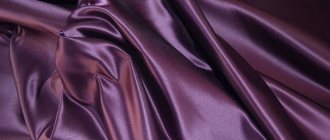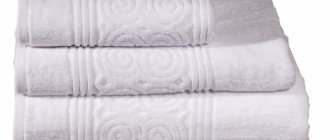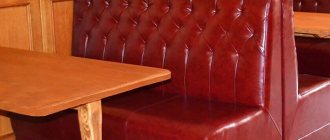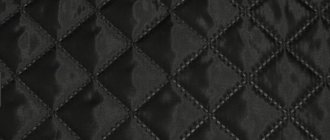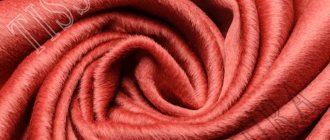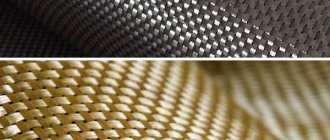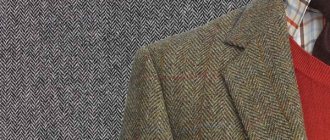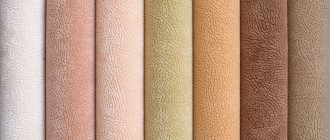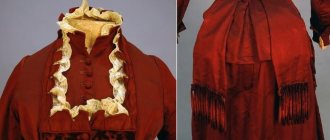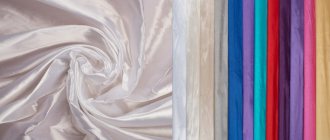Wool fabric is a textile fabric made from the hair of various animals. Wool is one of the most valuable and unique materials in its properties. Handicraft production of woolen cloth originated in the cities of the Ancient East, and the first mentions of it in Rus' date back to the 10th century.
The heyday of crafts and trade in this area occurred in the Middle Ages. France, England, Saxony, Florence and some other lands were famous for their wool fabrics, which could compete even with silk in the market. In the 18th century, machine production opened up new possibilities for processing wool. Mountainous countries have an advantage in production: for example, Italian fabric is famous for its quality.
Types of wool fabrics
Wool can be natural - sheared or combed from animals, factory - removed from skins (less durable) and regenerated - obtained from finished wool products. The most common types of woolen fabric are flannel, felt, velor, cashmere, gabardine, cloth, flannel, grosgrain, drape, etc.
Drape fabrics
Felt fabric
Cloth fabric
Merino and camel wool, cashmere, alpaca, angora, and mohair are used to make fabrics. The most common items are made from sheep wool of various breeds. The types of wool products are very diverse. An item of clothing, an accessory or wool curtains - the uniqueness of the material allows it to be used in completely different areas. Wool properties:
- high heat-shielding properties;
- low heat resistance;
- good hygroscopicity;
- elasticity;
- strength;
- durability;
- hypoallergenic;
- accumulation of static electricity;
- demand for care.
The entire range of woolen fabrics is usually divided into 2 main groups: woolen and wool blends. The composition of 80% wool blend threads can include both natural and synthetic additional fibers. Wool blend fabrics are often multi-component, containing different types of fibers. The addition of cotton threads reduces the cost of the product, but at the same time the appearance of the product becomes noticeably worse, and shrinkage and creasing noticeably increase. Nylon increases the mechanical properties of the fabric, but when added above 10% it makes it quite rigid.
You may also be interested in: Natural linen fabric in home textiles
Polyester fibers achieve the same effect, maintaining the softness of the fabric, but at the same time reducing hygroscopicity and increasing the tendency for pilling. Acrylic looks very much like wool, but reduces strength, so to compensate for wear resistance, manufacturers add nylon threads. Fabrics with viscose make quite strong, inexpensive and noble-looking things. Viscose transforms coarse material, making it softer and more flexible, but thin material, on the contrary, becomes worse in quality. One of the most expensive combinations is wool and silk fabric.
Production
The most common types of wool used for fabric production are:
- Mohair is obtained from the hair of goats living in Turkey, South Africa, and the USA. Products made from mohair are the most delicate and require special care.
- Alpaca, llama, suri - all these types are made from llama wool, but from different types.
- Merino - made from sheep hair.
- Camel.
- Angora - obtained from the wool of the Angora rabbit.
In this case, the following types are distinguished:
- Natural - cut directly from animals or collected during molting.
- Factory - removed from animal skins.
- Recovered - obtained by splitting woolen flaps and scraps of yarn.
Depending on the type of yarn and production methods, the material can be:
- Worsted - it consists of fine yarn, semi-fine and semi-coarse. The result is a thin fabric used for sewing suits and dresses.
- To obtain fine-woven fabrics, thin hardware yarn is used.
- Coarse cloth - it contains dense hardware yarn.
Types of wool fabrics
Depending on the type of yarn used for the manufacture of textile material, 3 types can be distinguished:
- Worsted (combed differently) fabrics - they have a smooth front side and a clearly defined weave of threads. They are made from combed yarn, twisted in 2 folds, which increases strength and keeps the shape of the finished product well. A wide range of weaves is used in production: small- or large-patterned, plain, twill and combined. And depending on the ratio of the number of vertical and horizontal threads, dense woolen fabric receives a greater or lesser degree of softness.
- Fine cloth fabrics are made from hardware yarn, most often dyed. The composition can include both natural wool and regenerated wool, and reverse wool, and combed tow. The fabric becomes softer and warmer than worsted. Most fine-woven fabrics have a small pile. It is obtained as a result of felling, or backcombing if the fabric is piled. Woolen fleecy fabric has a variety of weaves, just like seditious fabrics.
- Coarse cloth fabrics are produced using a hardware method from coarser and thicker fibers, due to which they are tough and prickly. Intensive rolling during finishing makes the fabric quite thick and heavy and, as a result, poorly draped. Coarse wool fabric has low ductility and shrinkage, as well as good wind and heat protection properties.
You may also be interested in: How to choose fabric for curtains - types and properties of materials
Types of wool fabrics and their properties
Modern industry produces a large number of materials. They are divided into two categories:
- pure wool - fabrics containing chemically produced fibers of about 10%;
- half-woolen - fabrics including viscose, acrylic, nylon, polyester fibers about 80%.
You might be interested in what the word kumach means: the origin and modernity of the fabric
Note! Currently, woolen fabric is produced with the addition of lavsan. As a result of its use, the properties of woolen fabric are improved: the degree of abrasion, creasing, and shrinkage are reduced. At the same time, the products become harder to the touch.
According to the choice and method of processing the yarn, woolen fabrics are divided into the following varieties:
- worsted, obtained from combed twisted yarn. The result is corrugated wool. The main property of the fabric is the smoothness of the surface;
- fine cloth with thick pile. The result is dense wool, which makes the fabric warmer, but more susceptible to dirt and dust;
- rough cloth with a soft or felt-forming surface. The fabric gains the properties of wear resistance, low drapability and plasticity.
Different types of woolen products
According to their purpose, they are divided into three types:
- for coats;
- for suits;
- for dresses.
In addition, there are intermediate types of fabrics that differ in the type of thread weave, density, types of processing, etc. They are also used to sew different types of clothing and household items.
Wool fabrics for sewing women's clothing
The most commonly used types of fabric for women's clothing are:
- plaid. This type of material is used in the production of skirts and dresses;
- rep is a fine wool that is well suited for suits, skirts, and trousers. It almost does not wrinkle, is resistant to fading, abrasion, and other types of chemical exposure;
- crepe. The fabric is made rough by using threads twisted together. The advantages of this plastic material are that it is excellent for sewing skirts, suits, and dresses of various styles;
- jacquard (wool) is a fabric made from threads of different colors, due to which convex patterns appear on it. Jackets, suits, and coats are made from it;
- jersey is a soft fabric that C. Chanel often used for her outfits;
- boucle is a loose thick fabric with a knotty surface. The disadvantage of this type of material is the difficulty in cutting and stitching.
Various wool fabrics
For women's coats
For coats, thick fabric with high density, good thermal insulation and wear resistance is most often used. Shine and gloss are not typical for such materials.
Woman pullover
For sewing men's coats
For men, wool is used, the characteristics of which include the properties of density and heaviness. Often things are sewn from waterproof gabardine and tweed. Also often used is fabric similar to that used in sewing women's coats.
You might be interested in Description of the veil, features of the fabric and use of the material for sewing curtains
Coat
For business suits
Business suits are almost always made from the same fabric as coats. In addition, they use tweed, which contains elements of colored yarn, making things look very fashionable and interesting.
Woman suit
For children's clothing
Clothes for children are made from soft materials. The fabric contains different substances: viscose, linen, etc. Most often, things are made from flannel, velor, flannel, plush.
Children's bodysuits
Important! Some materials use semi-thin threads, others use brushed or piled fabrics on both sides.
Wool products
A wide variety of men's, women's, and children's clothes for the cold season are sewn from wool:
- sweaters;
- dresses;
- costumes;
- coat;
- trousers;
- skirts;
- jackets;
- hats, scarves;
- mittens, gloves.
In addition, wool is used to make blankets, rugs, curtains and other home textiles. More than 120 options for wool blankets can be found.
Grooming
To care for wool products, use the following basic rules:
- Clothes made from wool are very hygienic and do not require frequent washing.
- It is not recommended to soak wool items.
- Wash in cold water (up to 35°C). Preference is given to hand washing. Washing in a machine should be done on a special delicate cycle and without spinning.
- Stains from wool are first removed with vinegar or hydrogen peroxide.
- It is better to wash white items separately so that dark fibers do not stick to them.
- The detergent must be specialized, ideally liquid. If you don’t have this in your arsenal, use baby shampoo. An alkaline environment makes the wool hard, and an acidic environment, on the contrary, softens it.
- Use conditioner to maintain softness and brightness.
- Dry items only in a horizontal position.
- Instead of traditional ironing, it is better to use a steamer.
- It is advisable to dry-clean suits and coats, but not more than 1-2 times a year.
- During long-term storage, use moth repellents and periodically ventilate things.
Wool fabric can be very different, but all types share the exceptional qualities of the material. Recently, wool blend fabrics have dominated the market. This is due to its low cost and improved properties. Determining the naturalness of wool is not difficult. If the ignited thread flares up instantly, but burns out for a long time, this is a natural product.
Save
Save
Types of wool
To begin with, let's divide wool fabrics into 2 groups according to their fiber composition:
- Pure wool - no more than 10–20% chemical fibers. Examples from our assortment: men's sleeveless vest made of camel wool, women's sweatshirt (thermal underwear) made of merino wool, children's warming socks made of yak wool.
- Wool blend - fabrics that contain a lot (but not more than 80%) of viscose, acrylic or other additive. For example: tights made of sheep wool with acrylic and lycra, thin children's socks made of camel wool.
As an additive to wool fibers, many manufacturers began to use lavsan, due to which the material becomes more resistant to abrasion and does not wrinkle or shrink. But it reduces the level of hygroscopicity and plasticity of the product. We sell wool clothing with other additives that do not have these disadvantages, such as acrylic and lycra.
Let's look at the main types of wool for clothing depending on the animal and understand the characteristics and benefits.
Angora
The threads are made from the fluff of Angora rabbits. The structure is very delicate, so the yarn must be strengthened by adding synthetic materials or other types of wool.
Angora is a fluffy yarn. Because of the latter property, it is better not to make children's things from it, because the fluff will get into the nose and mouth of the kids.
Main characteristics of Angora:
- ease;
- softness;
- subtlety;
- hypoallergenic;
- hygroscopicity (ability to absorb moisture).
But things made from angora quickly dry out and fall off, and pellets appear. To reduce these shortcomings to a minimum and make the item durable, angora is mixed with other wool, for example, sheep. You can order such clothes here.
Mohair
This is yarn made from the wool of Angora goats. From Turkish, muyhyar (mohair) translates as “best goat hair.” These goats began to be bred in Turkey, and the Turks also began producing yarn back in the 15th century. The most expensive mohair yarn is obtained from the wool of six-month-old goats from the first shearing.
Clothing with mohair warms in winter and cools in summer, because the material absorbs moisture well and “breathes.” Other characteristics of mohair:
- 1. Elasticity.
- 2. Hypoallergenic.
- 3. Products made from mohair do not fall off.
- 4. Volume, as the wool is fluffy.
- 5. Durability (fibers do not come out during use).
The disadvantage is that the fabric needs careful care.
You can experience the benefits of mohair products for yourself by purchasing a knee pad made from Angora goat wool.
Merino
Merino is a fine-wool sheep breed. They differ from beef sheep because the emphasis is on fiber quality.
Benefits of clothing made from merino wool:
- We let air through.
- Does not irritate the skin.
- Soft, pleasant to wear.
- Warms perfectly, does not electrify.
- Has antibacterial properties.
- Absorbs about a quarter of its weight in moisture while remaining dry.
Merino clothing is wear-resistant, elastic, therefore stretches well, and the fibers repel dirt. It warms very well due to the thinness of the fibers, between which there are many small spaces, which traps warm air.
Our assortment includes women's and men's clothing made from merino wool.
Yak
Yak wool is an exotic and extraordinary material. If you are looking for which animal has the warmest fur to buy clothes for the winter, think about the yak.
The fact is that yaks live in difficult natural conditions, where the temperature constantly fluctuates, sometimes decreasing, sometimes increasing. The animal has a thick undercoat, so it can stay in the cold for a long time and even sleep on frozen soil. Wool does not absorb moisture. An important feature of products made from yak wool is that they are light and soft, instantly warm and keep warm. This is also due to the fact that yaks are combed, not sheared.
Wool has a modest color palette and can be brown, gray or dark gray. It is often used in the production of children's clothes because it is suitable for delicate and sensitive skin. In addition to clothing, it is used to make blankets, blankets, warming belts, etc. It does not hinder movement, is easy to care for, the fabric is high quality and durable.
Our assortment includes clothes made from a mixture of yak and sheep wool. We also sell socks made from pure yak wool.
Camel
The camel can be put on par with the yak if you want to figure out which wool is the best. The wool is hollow, which gives excellent thermal insulation and lightness. In addition, it is an excellent insulator as it maintains body temperature. Therefore, even in extreme heat the camel does well.
Features of camel wool:
- Easy.
- Very durable.
- Almost does not absorb dust.
- Unique thermal insulation properties.
- It is not electrified, so the heat is useful and dry.
- Instantly absorbs moisture (much faster than any textile).
- The hollow structure of the fibers ensures natural air circulation.
The down from the chest of camel calves is valued even more; it is the softest and finest. Up to the age of one year, all babies are white. As the hair grows, the color of the coat also changes. Camel down cannot be dyed.
Camel wool is used to make blankets, rugs, pillows, mattresses, as well as various wardrobe items for men, women and children. We have a lot of this.
Dog
When answering the question of what animal wool is used to make therapeutic clothing, many will remember dog hair. Indeed, many products are made from it: belts, knee pads, socks, bandages, insoles, collars.
Features of products made from dog hair:
- Excellent heat retention.
- Activate muscle activity.
- They have an anti-inflammatory effect.
- Promote active blood circulation.
The maximum effect is achieved by wool that is very itchy. It perfectly circulates blood, affecting nerve endings. Thanks to this, blood flows to the place where the wool is applied, warming it up, reducing swelling and pain.
